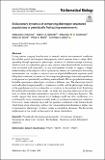Files in this item
Evolutionary dynamics of competing phenotype-structured populations in periodically fluctuating environments
Item metadata
| dc.contributor.author | Ardaševa, Aleksandra | |
| dc.contributor.author | Gatenby, Robert A. | |
| dc.contributor.author | Anderson, Alexander R. A. | |
| dc.contributor.author | Byrne, Helen M. | |
| dc.contributor.author | Maini, Philip K. | |
| dc.contributor.author | Lorenzi, Tommaso | |
| dc.date.accessioned | 2019-10-24T16:30:02Z | |
| dc.date.available | 2019-10-24T16:30:02Z | |
| dc.date.issued | 2020-02 | |
| dc.identifier | 261900544 | |
| dc.identifier | af75980c-e301-4503-9401-039c02d51fdc | |
| dc.identifier | 85076527576 | |
| dc.identifier | 000494183100002 | |
| dc.identifier.citation | Ardaševa , A , Gatenby , R A , Anderson , A R A , Byrne , H M , Maini , P K & Lorenzi , T 2020 , ' Evolutionary dynamics of competing phenotype-structured populations in periodically fluctuating environments ' , Journal of Mathematical Biology , vol. 80 , pp. 775–807 . https://doi.org/10.1007/s00285-019-01441-5 | en |
| dc.identifier.issn | 0303-6812 | |
| dc.identifier.other | ArXiv: http://arxiv.org/abs/1905.11712v2 | |
| dc.identifier.uri | https://hdl.handle.net/10023/18761 | |
| dc.description | Funding: UK Engineering and Physical Sciences Research Council (EPSRC) and the Medical Research Council (MRC) (grant no. EP/L016044/1) (AA). | en |
| dc.description.abstract | Living species, ranging from bacteria to animals, exist in environmental conditions that exhibit spatial and temporal heterogeneity which requires them to adapt. Risk-spreading through spontaneous phenotypic variations is a known concept in ecology, which is used to explain how species may survive when faced with the evolutionary risks associated with temporally varying environments. In order to support a deeper understanding of the adaptive role of spontaneous phenotypic variations in fluctuating environments, we consider a system of non-local partial differential equations modelling the evolutionary dynamics of two competing phenotype-structured populations in the presence of periodically oscillating nutrient levels. The two populations undergo heritable, spontaneous phenotypic variations at different rates. The phenotypic state of each individual is represented by a continuous variable, and the phenotypic landscape of the populations evolves in time due to variations in the nutrient level. Exploiting the analytical tractability of our model, we study the long-time behaviour of the solutions to obtain a detailed mathematical depiction of the evolutionary dynamics. The results suggest that when nutrient levels undergo small and slow oscillations, it is evolutionarily more convenient to rarely undergo spontaneous phenotypic variations. Conversely, under relatively large and fast periodic oscillations in the nutrient levels, which bring about alternating cycles of starvation and nutrient abundance, higher rates of spontaneous phenotypic variations confer a competitive advantage. We discuss the implications of our results in the context of cancer metabolism. | |
| dc.format.extent | 33 | |
| dc.format.extent | 1413445 | |
| dc.language.iso | eng | |
| dc.relation.ispartof | Journal of Mathematical Biology | en |
| dc.subject | Periodically fluctuating enviroments | en |
| dc.subject | Evolutionary dynamics | en |
| dc.subject | Spontaneous phenotypic variation | en |
| dc.subject | Bet-hedging | en |
| dc.subject | Non-local partial differential equations | en |
| dc.subject | QA Mathematics | en |
| dc.subject | QH301 Biology | en |
| dc.subject | T-NDAS | en |
| dc.subject | SDG 3 - Good Health and Well-being | en |
| dc.subject.lcc | QA | en |
| dc.subject.lcc | QH301 | en |
| dc.title | Evolutionary dynamics of competing phenotype-structured populations in periodically fluctuating environments | en |
| dc.type | Journal article | en |
| dc.contributor.institution | University of St Andrews. Applied Mathematics | en |
| dc.identifier.doi | https://doi.org/10.1007/s00285-019-01441-5 | |
| dc.description.status | Peer reviewed | en |
This item appears in the following Collection(s)
Items in the St Andrews Research Repository are protected by copyright, with all rights reserved, unless otherwise indicated.

